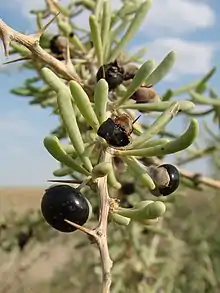| Lycium ruthenicum | |
|---|---|
 | |
| Lycium ruthenicum fruits | |
| Scientific classification | |
| Kingdom: | Plantae |
| Clade: | Tracheophytes |
| Clade: | Angiosperms |
| Clade: | Eudicots |
| Clade: | Asterids |
| Order: | Solanales |
| Family: | Solanaceae |
| Genus: | Lycium |
| Species: | L. ruthenicum |
| Binomial name | |
| Lycium ruthenicum Murray | |
Lycium ruthenicum (Chinese: 黑果枸杞; pinyin: hei guo gou qi), is a flowering plant commonly known as Russian box thorn in the West.[1] is a species of flowering plant in the nightshade family which can be found in Central Asia, southern part of Russia, throughout Northwest China,[2] Northern India and Pakistan.[3] Also commonly known as black fruit wolfberry, siyah goji, and kaokee.[4]
Description
The species is either 1.8 centimetres (0.71 in),[1] 20–50 centimetres (7.9–19.7 in),[2] 20–150 centimetres (7.9–59.1 in),[5] or 180 centimetres (71 in) tall.[3] The leaves are either 5–30 millimetres (0.20–1.18 in),[5] 0.6–2.5 centimetres (0.24–0.98 in),[1] or 6–25 millimetres (0.24–0.98 in) by 1–1.5 millimetres (0.039–0.059 in).[3] It have 2-4 sepals each one of which is bell-shaped and 3–4 millimetres (0.12–0.16 in) long.[5] Pedicels are either 5–10 millimetres (0.20–0.39 in) long[2] or can be as long as it sepals. The calyx is 2.5–3.5 millimetres (0.098–0.138 in) long[3] but can be companulate and exceed 4–5 millimetres (0.16–0.20 in).[2] Corolla's tube is 5–7 millimetres (0.20–0.28 in) long with stamens have 5–8 millimetres (0.20–0.31 in) long berries[3] (which can sometimes grow up to 9 millimetres (0.35 in))[2] which are also broad and globose.[2] The fruits' seeds are brown coloured and are 1.5–2 millimetres (0.059–0.079 in) long.[2] The flowering time is June to August[3] but can sometimes bloom in May too. Fruits mature from August to October.[2]
Distribution and uses
In India, it grows in Nubra Valley where it is used by native people to cure blindness in camels. In Central Asia and Northwest China the species grows on elevation of 400–3,000 metres (1,300–9,800 ft)[1] in saline deserts, sands and roadsides.[2]
References
- 1 2 3 4 "Russian Box Thorn". Flowers of India. Retrieved December 1, 2013.
- 1 2 3 4 5 6 7 8 9 "Lycium ruthenicum Murray". 17. Flora of China: 302.
{{cite journal}}: Cite journal requires|journal=(help) - 1 2 3 4 5 6 Murray. "Lycium ruthenicum Murray". Flora of Pakistan: 33.
{{cite journal}}: Cite journal requires|journal=(help) - ↑ "Black fruit wolfberry". abetteryouplus. Archived from the original on May 30, 2016. Retrieved April 22, 2016.
- 1 2 3 "Lycium ruthenicum Murr". Archived from the original on December 2, 2013. Retrieved December 1, 2013.
Complete guide of black wolfberry. Sinaeangift. Retrieved May 25, 2017.
Notes
- Murray (1779). "Lycium ruthenicum". 2. Comment. Soc. Sci. Gotting: 9–13.
{{cite journal}}: Cite journal requires|journal=(help) - Boiss. (1879). "Lycium ruthenicum". 4. Fl. Or.: 290.
{{cite journal}}: Cite journal requires|journal=(help) - Clarke (1968). "Lycium ruthenicum". 241. Feinburn in Collect. Bot.: 574.
{{cite journal}}: Cite journal requires|journal=(help) - Schoenbeck-Temesy, 31
- Baytop, 448
External links
 Data related to Lycium ruthenicum at Wikispecies
Data related to Lycium ruthenicum at Wikispecies- "Lycium ruthenicum". Plants for a Future.